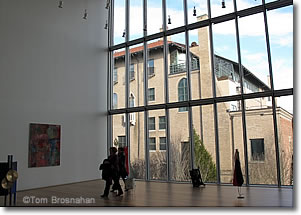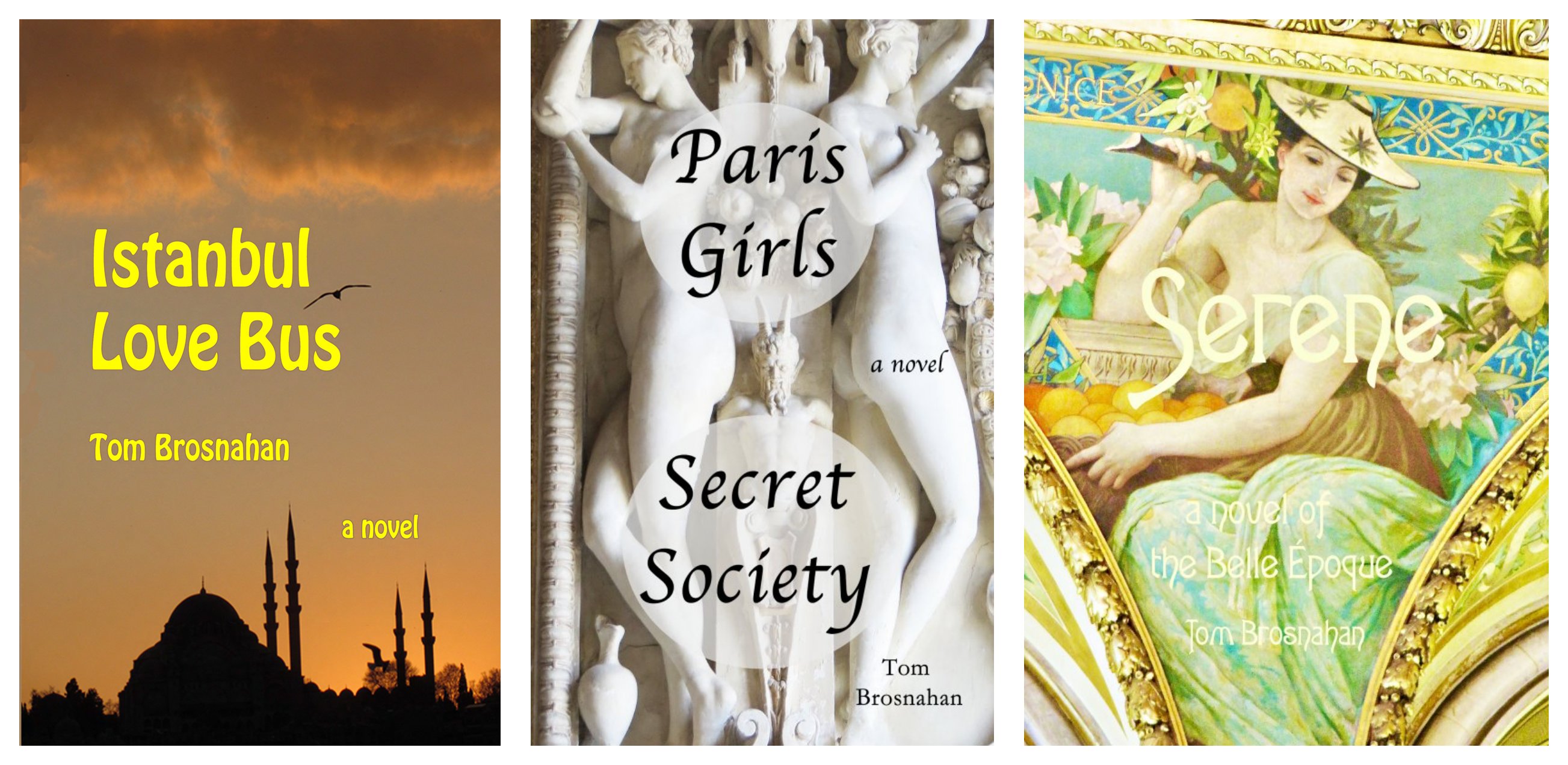Museum of Fine Arts
The Museum of Fine Arts, a great Greek temple at 465 Huntington Avenue (Avenue of the Arts; map), houses one of the world's finest collections of artworks, second in the USA only to New York City's Metropolitan Museum of Art.
The museum's collections include such iconic works as Gilbert Stuart's Athenaeum Head portrait of George Washington; Renoir's Le Bal a Bougival; Burne-Jones's The Love Song; Whistler's Girl in a White Dress; works by Van Gogh, Gauguin, Degas, lots of Monets; Death of Maximilian by Manet; and works by Japanese, Chinese, European, medieval, Renaissance, and baroque masters are all well represented.
A fine collection of Paul Revere silver, several rooms taken from French chateaux, full-size Japanese temple, a 9th-century Spanish chapel, Egyptian mummies, Assyrian seals—the list goes on to the treasures of almost 200 galleries. There are several dining options, from grab-and-go sandwiches to a semi-formal sit-down restaurant.
To get to the MFA by subway, take a Green Line "E" train ("Heath Street ") along Huntington Avenue and get off at the second stop above ground.
Isabella Stewart Gardner Museum
For her Boston residence, Mrs Isabella Stewart Gardner (1840-1924) had antique doors, columns, windows, and other architectural and decorative elements brought from Europe and assembled around an open court topped by a glass canopy at 2 Palace Road/280 The Fenway (map). She called her palace Fenway Court after the Back Bay Fens which it faced across the Fenway boulevard (map).
If you have a full day when you visit the Museum of Fine Arts, plan to spend at least a few hours of it at the Isabella Stewart Gardner Museum nearby at 280 The Fenway.
The House & the Collection
"Mrs Jack" Gardner early developed a love of art, and with her considerable wealth and the services of connaisseur Bernard Berenson she set about to build an outstanding collection which now includes almost 300 paintings, almost as many pieces of sculpture, close to 500 pieces of furniture, and hundreds of works in textiles, ceramics, and glass.
Most of the holdings are from the great periods of European art, but classical and Oriental civilizations are also represented. Not the least of the exhibits is Fenway Court itself, which she had built to hold the collection in 1902.
The beautiful glass-roofed interior courtyard is always planted with flowers, in bloom summer and winter, and several fountains bubble merrily at one end.
Upstairs in one room is a dramatic portrait of "Mrs Jack" herself, displayed with various masterpieces above a floor covered in tiles from Henry Mercer's Moravian tile and pottery works in Bucks County, Pennsylvania.
Along a corridor nearby, look for mementos of Mrs Gardner's years, including letters from many of the great and famous of the turn of the century.
The museum has a nice cafe where light meals are served.
The Great Theft
In March 1990, this lovely museum suffered a tragedy when art thieves disguised as police officers tricked the guards and made off with 12 masterpieces, including paintings by Degas and Rembrandt and a rare Chinese vase, worth hundreds of millions of dollars. These irreplaceable works will probably end up in a vault somewhere, unavailable to the public, because of some thieves' greed and selfishness.
Institute of Contemporary Art
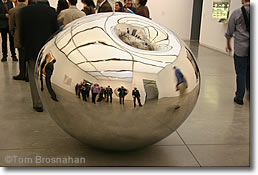
Reflections at the ICA
Located on Fan Pier at 100 Northern Avenue, on the east side of Fort Point Channel in the Seaport District (map), Boston's Institute of Contemporary Art ("the ICA") is within walking distance of many downtown Boston hotels and the Boston Convention and Exhibition Center (BCEC). In fact, Boston's excellent Harborwalk is literally incorporated into the ICA building.
Opened in December 2006, the ICA was cleverly designed by the architectural firm of Diller Scofidio + Renfro to be a multidisciplinary art center offering highly adaptable spaces for any sort of work. Because the galleries are on the top floor, they all get gentle, plenteous natural light by means of an elaborate adjustable skylight system and filtering scrims.
Besides the galleries featuring the ICA's permanent collection and changing exhibits, there's a 324-seat theater, a "Mediatheque" with public computers for artwork, design and comments, an Art Lab, ICA Store, and the Water Café, an indoor-outdoor Wolfgang Puck eatery.
Boston's ICA was founded in 1936, and is thus among the oldest museums devoted to modern art. For much of its life, the ICA was near the Prudential Center in a historic Richardsonian structure.
Its present location, on Fan Pier, off Seaport Boulevard near the Moakley Courthouse, several good hotels, the Seaport World Trade Center, Flynn Cruiseport Boston, and Boston Convention & Exhibition Center, is even more convenient (map).
Other Fine Arts Museums
The museums mentioned above are the Big Three, but Greater Boston has a dozen more fine arts museums within easy reach. More...
Boston Children's Museum
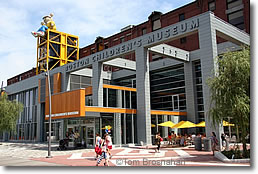
Boston Children's Museum
The Boston Children's Museum is in the Seaport District at 300 Congress Street just across Fort Point Channel from South Station and the Financial District (map). (Subway: Red Line to South Station)
Kids from infants through preschoolers to early adolescents will find exhibits to entertain, educate and delight them, from a completely padded and carpeted infants' area to art rooms, climbing structures, hands-on science experiments, interactive displays, and plenty more.
Designed by famed Boston architect Peter Kuttner and his colleagues at Cambridge Seven Associates, the museum incorporates both the historic brick wool warehouse (1888) and 21st-century design elements, features and conveniences.
Boston's Harborwalk passes the front of the museum, where trees, tables and benches serve patrons of a restaurant located in the museum building.
Take an MBTA subway Red Line train to South Station, and follow the signs to Museum Wharf (map).
Museum of Science
Science and technology have always been strong suits in Boston, what with the Massachusetts Institute of Technology right across the Charles River in Cambridge, Wentworth Institute of Technology, and other science-centered institutions. The museum is located at 1 Science Park, right on the Charles River Dam between Boston and Cambridge (map).
Children are especially delighted here, for they can push buttons to start dozens of various exhibits and demonstrations ranging from fluid dynamics to the human circulatory system; stand next to a replica of America's first rocket launcher built by Robert Goddard of Auburn MA in 1926; and walk around a tremendous replica of Tyrannosaurus rex.
Special exhibits include the Hayden Planetarium with celestial shows on various themes daily, and the Omnimax theater, but my personal favorite is the Van de Graaf Generator, which makes real lightning (thunderclaps and all) in a thrilling (and sorta scary) exhibit that no one ever forgets.
Transportation & Parking
The museum has its own parking garage, with reasonable fees, so parking is usually not a problem.
To get there by subway, take an MBTA subway Green Line train toward Lechmere to the Science Park station.
Boston Athenaeum
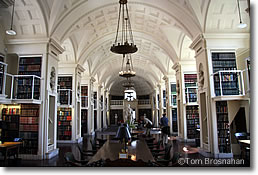
Boston Athenaeum
The Boston Athenaeum, tucked away atop Beacon Hill at 10-1/2 Beacon Street, just off Boston Common and a few steps from the Massachusetts State House (map), is a grand old Boston institution founded in 1807, at a time when books were valuable and good collections of books more valuable than the sum of their parts.
Private libraries were the norm, but collective private libraries—in which several people or families of wealth combined their respective collections, or sums of money to purchase books, for the good of all contributors—were gaining in popularity.
The Athenaeum's picture and sculpture collections were once, de facto, Boston's premier art museum. (Gilbert Stuart's famed "Athenaeum Head" painting of George Washington was so called because it was owned by the Boston Atheneum for 150 years. It is now owned jointly by the Smithsonian Institution and Boston's Museum of Fine Arts.)
The Athenaeum is still a private library owned by such a collective: 1049 Proprietors, who can pass right of ownership in the collection by heredity. The nearest subway station is Park Street.
John F Kennedy Library & Museum
The John F Kennedy Presidential Library & Museum, America's tribute to one of its most popular presidents ever, is at Columbia Point in the Dorchester section of Boston (map).
Designed by I M Pei, the library features exhibits introduced by a 30-minute movie on the late president's life. Then, arranged in chronological order, it displays JFK memorabilia from his christening dress, PT-109 uniform, and flight jacket worn when president, to papers relating to the Bay of Pigs and Cuban Missile Crisis. There's also a re-creation of the White House's Oval Office as it was when he was president, with his desk and rocking chair.
Boston's Harborwalk goes all the way around Columbia Point with fine views of Dorchester Bay. Just off the Harborwalk by the JFK Library are picnic tables in a grove of shade trees.
Between the JFK Library and the University of Massachusetts - Boston campus stands the Massachusetts Archives which includes the fine small Commonwealth Museum outlining the history of the Commonwealth of Massachusetts. Admission to the museum is free.
Take the MBTA Red Line subway to JFK/U Mass Station. From the station it's a 1.1-mile (1.8-km, 25-minute) walk southeast to Columbia Point and the JFK Library (map), or you can take one of the free shuttle buses from the station. About every 20 minutes, a Line 2 shuttle bus takes you right to the Library. More frequently, Line 1 buses take you to the University of Massachusetts - Boston campus, whence it's a 10-minute walk past the Massachusetts Archives to the JFK Library.
If you're driving, follow I-93 (also designated as US 1 and MA Routes 3, 15, and 16, and the Southeast Expressway) south from the city center, taking Exit 15 at Columbia Road and Morrissey Boulevard, and follow the signs.
